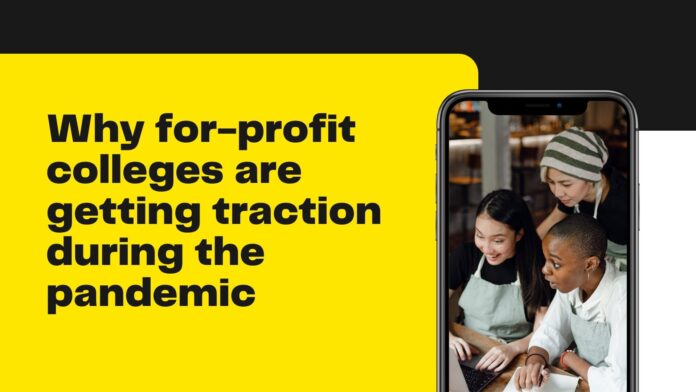As soon as news of the pandemic struck, universities, colleges, and schools began giving notices. A few universities did all they could to shift operations online. However, not many were able to set up remote learning options in the scramble and hoopla of it all.
Even now as restrictions and social distancing guidelines have become the norm, it has become increasingly apparent that the future of education is online, something that many for-profit colleges have known for decades.
The pandemic has forced institutions of higher education to confront long-standing issues that have pervaded the education system such as the sharp climb in tuition costs. In the next 5 years, even after the pandemic is ling over, universities will look to shift the majority of their courses and classes online.
Although this might mean fewer international enrolments, it will force universities to amend so that courses can be more relevant to the needs of the local and regional communities. All these things were bound to happen in the future; the pandemic has only helped to speed things up. As universities scramble to meet these pressing changes, the fiscal stance isn’t looking great.
Revenues continue to plummet for traditional schools that have been unable to cope fast enough. As many students sit out the pandemic at home or reconsider plans, for-profit universities are stepping up to fill the gap. Students have realized that they do not need to be pinned down or held captive to a traditional learning structure.
Instead, many are opting to chart their learning experiences themselves with more cost-effective and efficient alternatives. So what are some of the other reasons why profit colleges are receiving a lot of attention during these grim times?
Online universities are becoming the norm
Living at home while studying online has fast become the best option for students and parents afraid of getting infected at densely populated dorms and living quarters. This comes as great news for for-profit colleges that have been offering online education for years. Rather than take a gap year, most students would rather learn online particularly if their school is residential and far-flung.
With online learning, students still sit for all their lectures and seminars, such that disruptions are kept to a minimum. Lecturers are taking questions via chat features, which has made some of the material even more accessible.
Even before the pandemic, several schools were already looking into adopting ed-tech in various ways. Learners like the flexibility offered by for-profit schools. These positive experiences are some of the reasons why profit colleges are garnering attention during the pandemic.
For-profit universities have more experience
As mentioned for-profit universities have been offering online courses for decades before the pandemic struck. As many struggle to adjust, the college admissions process in the coming months is bound to be more complex as a result of the complexities surrounding online test-taking and learning.
The process of moving university courses online is slated to cost colleges and universities billions. For-profit universities have the financial muscle to handle the online move. But traditional schools will have to bear the cost of the move and ensure that their digital transformation is enduring especially after lagging behind many profit schools for years.
All of this will take some time for traditional colleges and universities to get used to. And even though all institutions, for-profit or not, are facing financial challenges, for-profit universities are better placed to endure the storm. As it stands, the online education sector is expected to reach $350 Billion by 2025.
Profit schools increase access
For-profit universities have increased access to education. Learners who would otherwise be able to take their preferred courses now have the option to, regardless of where in the country they are located. As for-profit online education continues to become more established, more low-income students have more variety than ever before.
Aside from low-income students, profit universities also offer more access to racial minority learners. Many profit schools offer non-traditional learning opportunities such as practical learning and skill-based training that better equips the students for life after graduation.
Profit universities have always kept tabs on the next big thing and this trend should continue in the coming years. What this will do is give learners access to more learning opportunities as profit schools look to expand into new and booming fields. Profit schools will also eliminate fields that students no longer find attractive, thus increasing the demand for their services further.
Profit schools have better incentives
For-profit institutions are more agreeable to learners because most such institutions have long-standing partnerships with prospective employers. For-profit schools actively make an effort to build relationships with businesses and corporations thus ensuring that most of their students are employed after graduating.
By comparison, traditional colleges and schools rarely offer students the incentive or provide job search assistance. With gainful employment becoming a real concern post-pandemic, for-profit institutions promise to help students land better jobs. Now all profit schools should expect to be under the microscope as parents and stakeholders will be observing keenly to see how well they perform in terms of helping graduates secure employment opportunities.
Final Thoughts
Profit universities are nimbler compared to their traditional counterparts especially when it comes to creating and implementing impressive courses, programs, and curriculums. And the demand for the programs offered is high.
Since there is a clear market for for-profit schools, these colleges should keep gaining traction long after the pandemic is gone. While online institutions still comprise a small fraction of the multi-billion-dollar industry, the higher education sector is ripe for transformation. Learners’ appetite for online courses will keep growing as profit schools become lifeguards.
Where profit schools were previously viewed as a threat they have now stepped up to come to the rescue. Whether online learning comes in the form of increased use of language apps, virtual learning and tutoring, video and seminar conferencing, one thing is clear; that there is no going back.











